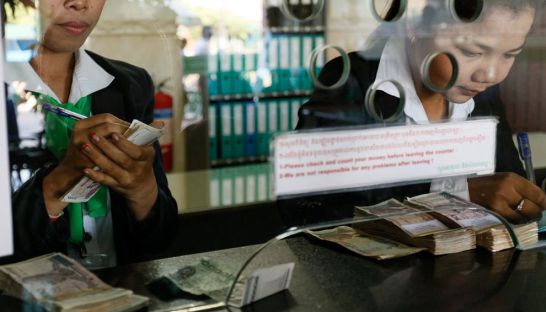MFI slowdown: real or illusory?
MFI slowdown: real or illusory?
After several years of rapid growth, the expansion of credit provided by the Kingdom’s myriad microfinance institutions (MFIs) stalled abruptly last year, raising concerns poorer Cambodians could be pushed toward loan sharks to obtain credit or cover their debts, the World Bank said in its latest economic update on Cambodia.

It noted that credit growth in the Kingdom’s microfinance sector peaked in 2014 at more than 50 percent year-on-year before slowing to a crawl in 2016. The combined loan portfolio of all MFIs peaked in March 2016 before dropping to $3.16 billion by November. Total MFI credit growth capped out at just 4.7 percent last year.
According to the report, the total number of households served by all microfinance institutions has also declined, dropping to just 2.14 million households in 2016, from 2.19 million one year earlier.
Meanwhile, the microfinance sector’s non-performing loan (NPL) ratio doubled last year, rising to 1.5 percent, from 0.7 percent in 2015.
“In environments of rapidly increasing credit, as experienced in Cambodia over the past six years, the quality of portfolios is often masked by the pace at which portfolios grow,” the report said. “Only with a shock or a major slowdown do the underlying vulnerabilities – for example, large numbers of borrowers taking new loans to repay old ones suddenly become apparent.”
The World Bank report suggested several possible reasons behind the stagnation of MFI credit.
“Initial observations indicate that there is stronger competitions from the growing number of unregulated parallel microfinance operations offering credit, including private money-lenders,” the report said. “As competition heats up, the criteria for obtaining loans are being relaxed, in particular by informal and unregulated money-lenders.
Many households therefore appear to be relying increasingly on informal money-lenders for quick, uncollateralised cash to make loan repayments, cover medical expenses, of make property repairs.”
Other possibilities cited include market saturation, and slower demand from farmers and traders due to tighter restrictions on informal commodity exports. The report also noted a decline in outstanding credit resulting from the reclassification of Sathapana MFI as a commercial bank in 2016 following its merger with Maruhan Japan Bank.
Sathapana, previously the country’s second-largest MFI, had nearly $600 million in outstanding loans at the end of 2016. Had this total been included in the National Bank of Cambodia (NBC) calculation of total MFI credit, it would have pushed that total to $3.7 billion last year – a formidable 27 percent year-on-year increase.
Bun Mony, adviser to the Cambodian Microfinance Association and former CEO of Sathapana Bank, said the exclusion of Sathapana’s loan portfolio from the calculations was the main reason for the apparent stagnation in MFI credit growth. However, he also attributed slower demand for credit by farmers as the result of last year’s prolonged drought and low agricultural commodity prices.
“To maintain or boost the loan growth rate, government institutions need to ensure market demand of major agricultural crops such as rice, pepper, cashew nuts and rubber,” he said.
Hout Ieng Tong, CEO of Hattha Kaksekar Limited, cited additional factors for the slowdown in credit growth, such as the central bank’s imposition of a liquidity coverage ratio on microfinance deposit-taking institutions – a measure he said resulted in curbing lending.
However, he said the slowdown of MFI credit growth was a positive for the sector.
“I think the slower growth of credit is good as it turns toward healthier growth that provides benefits to all parties,” he said.














